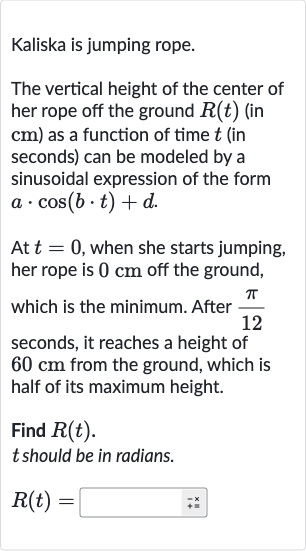AI tutor
Welcome to Bytelearn!
Let’s check out your problem:

Kaliska is jumping rope.The vertical height of the center of her rope off the ground (in ) as a function of time (in seconds) can be modeled by a sinusoidal expression of the form .At , when she starts jumping, her rope is off the ground, which is the minimum. After seconds, it reaches a height of from the ground, which is half of its maximum height.Find . should be in radians.
Full solution
Q. Kaliska is jumping rope.The vertical height of the center of her rope off the ground (in ) as a function of time (in seconds) can be modeled by a sinusoidal expression of the form .At , when she starts jumping, her rope is off the ground, which is the minimum. After seconds, it reaches a height of from the ground, which is half of its maximum height.Find . should be in radians.
- Rephrasing the function: Let's first rephrase the "What is the function that models the vertical height of the center of Kaliska's jump rope off the ground as a function of time?"
- Determining the vertical shift: Since the rope starts at off the ground at , which is the minimum height, we know that the vertical shift in the sinusoidal function is . This is because the cosine function starts at its maximum value when there is no horizontal or vertical shift, and since we're starting at the minimum, the vertical shift must be to flip the cosine wave.
- Finding the amplitude: Given that the rope reaches half of its maximum height after seconds, and this height is cm, we can deduce that the maximum height of the rope is twice this value, which is cm. Therefore, the amplitude of the sinusoidal function is cm.
- Calculating the value of : Now we need to find the value of , which is related to the period of the function. Since the rope reaches half of its maximum height at seconds, and knowing that the cosine function reaches half of its maximum value at radians (since ), we can set up the equation to solve for .
- Solving for : Solving the equation for , we get . Multiplying both sides by to isolate , we get .
- Writing the function : Now that we have all the parameters for the sinusoidal function, we can write the function as , which simplifies to .
More problems from Write exponential functions: word problems
QuestionGet tutor help
QuestionGet tutor help
QuestionGet tutor help
QuestionGet tutor help
QuestionGet tutor help
QuestionGet tutor help
QuestionGet tutor help
QuestionGet tutor help
QuestionGet tutor help
